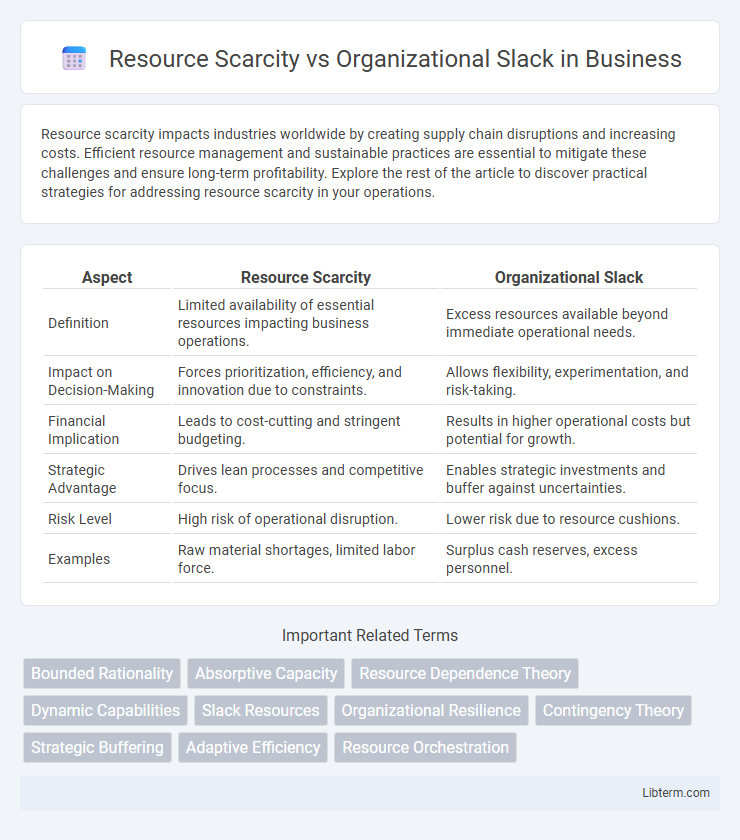Resource scarcity impacts industries worldwide by creating supply chain disruptions and increasing costs. Efficient resource management and sustainable practices are essential to mitigate these challenges and ensure long-term profitability. Explore the rest of the article to discover practical strategies for addressing resource scarcity in your operations.
Table of Comparison
| Aspect | Resource Scarcity | Organizational Slack |
|---|---|---|
| Definition | Limited availability of essential resources impacting business operations. | Excess resources available beyond immediate operational needs. |
| Impact on Decision-Making | Forces prioritization, efficiency, and innovation due to constraints. | Allows flexibility, experimentation, and risk-taking. |
| Financial Implication | Leads to cost-cutting and stringent budgeting. | Results in higher operational costs but potential for growth. |
| Strategic Advantage | Drives lean processes and competitive focus. | Enables strategic investments and buffer against uncertainties. |
| Risk Level | High risk of operational disruption. | Lower risk due to resource cushions. |
| Examples | Raw material shortages, limited labor force. | Surplus cash reserves, excess personnel. |
Understanding Resource Scarcity in Organizations
Resource scarcity in organizations refers to the limited availability of essential assets such as capital, labor, and technology, which constrains operational efficiency and strategic decision-making. Understanding resource scarcity involves analyzing how organizations allocate these finite resources to sustain production, innovation, and competitive advantage amid market fluctuations. Effective management of resource scarcity often requires balancing immediate operational needs with long-term investment priorities to avoid organizational slack and optimize overall performance.
Defining Organizational Slack
Organizational slack refers to the excess resources available within a company beyond what is necessary for its immediate operational requirements, serving as a buffer to absorb shocks and facilitate adaptation. These surplus resources can include financial reserves, labor, or capacity that enable innovation and flexibility under resource scarcity conditions. By maintaining organizational slack, firms can mitigate risks associated with resource scarcity, ensuring stability and strategic maneuverability in uncertain environments.
Origins and Causes of Resource Scarcity
Resource scarcity originates from limited availability of essential inputs such as capital, labor, or raw materials, often driven by external market fluctuations, supply chain disruptions, or geopolitical conflicts. Organizations facing resource scarcity typically operate under constrained environments where demand exceeds supply, causing intensified competition and prioritization challenges. Understanding these origins helps firms strategically manage organizational slack to buffer against unpredictable resource shortages and maintain operational resilience.
Types and Forms of Organizational Slack
Organizational slack manifests in three primary types: absorbed slack, which includes excess resources tied up in processes like surplus labor or outdated equipment; unabsorbed slack, representing readily available surplus such as cash reserves or idle capacity; and potential slack, encompassing untapped resources like skills or innovative capabilities. These forms allow firms to buffer against resource scarcity by providing flexibility and adaptability in resource allocation. Effectively managing these slack types helps organizations mitigate risks, capitalize on opportunities, and maintain competitive advantage amidst fluctuating resource availability.
Impacts of Resource Scarcity on Organizational Performance
Resource scarcity directly constrains an organization's ability to invest in innovation, talent acquisition, and operational efficiency, leading to reduced performance and competitive disadvantage. Limited financial, human, or material resources increase pressure on existing assets, often causing delays in project completion and lowered quality of outputs. Organizations facing resource scarcity frequently experience decreased employee morale and strategic flexibility, impairing long-term growth and adaptability in dynamic markets.
The Role of Slack in Facilitating Innovation
Organizational slack, defined as surplus resources beyond the minimum required for operations, plays a critical role in facilitating innovation by providing a buffer that enables experimentation and creative risk-taking. This reserved capacity supports the development of novel ideas without the immediate pressure of resource constraints that characterize resource scarcity, fostering an environment where exploratory projects can thrive. By reducing the stress on core resources, slack enhances organizational flexibility, allowing teams to pursue innovative initiatives that may lead to competitive advantages and long-term growth.
Balancing Efficiency and Flexibility: Resource Scarcity vs Slack
Balancing resource scarcity and organizational slack is crucial for optimizing both efficiency and flexibility in business operations. Resource scarcity forces firms to prioritize the efficient allocation of limited assets, driving innovation and cost control, while organizational slack provides a buffer that enhances adaptability and resilience to unforeseen challenges. Maintaining an optimal level of slack ensures organizations can respond to market volatility without compromising operational efficiency or strategic goals.
Strategic Responses to Resource Constraints
Organizations facing resource scarcity adopt strategic responses such as prioritizing core activities, streamlining operations, and innovating to maximize efficiency. Organizational slack, defined as excess resources beyond immediate needs, allows firms to absorb shocks and invest in exploratory projects that can mitigate the impact of constraints. Balancing resource scarcity with the strategic use of slack enables firms to maintain flexibility and sustain competitive advantage under volatile market conditions.
Managing Slack for Competitive Advantage
Managing organizational slack effectively provides a buffer that enables companies to adapt rapidly to resource scarcity, maintaining operational resilience and strategic flexibility. Strategic allocation of slack resources fosters innovation and supports risk-taking without jeopardizing core activities, enhancing competitive advantage in volatile markets. Firms balancing optimal slack levels can capitalize on market opportunities by reallocating excess resources swiftly, ensuring sustained growth despite resource constraints.
Future Challenges: Navigating Resource Scarcity and Slack
Future challenges in navigating resource scarcity and organizational slack emphasize optimizing limited assets while avoiding excess capacity that leads to inefficiency. Adaptive strategies must balance conserving critical resources with maintaining sufficient slack to enable innovation and resilience in volatile markets. Leveraging data analytics and flexible resource allocation systems enhances decision-making amid uncertainty, ensuring sustainable competitive advantage.
Resource Scarcity Infographic

 libterm.com
libterm.com